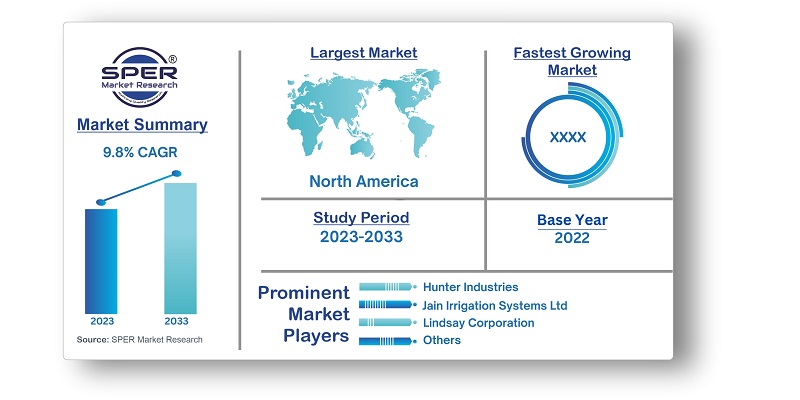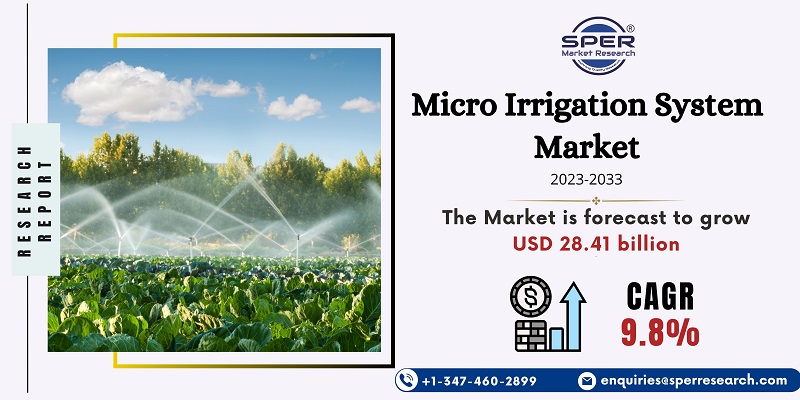
Micro Irrigation System Market Growth, Size, Trends, Revenue, Share, Scope and Future Outlook
Micro Irrigation System Market Size- By Mechanism, By Component, By End User, By Cultivation Technology, By Application- Regional Outlook, Competitive Strategies and Segment Forecast to 2033
| Published: Jan-2024 | Report ID: AGRI2402 | Pages: 1 - 225 | Formats*: |
| Category : Agriculture | |||
- June 2023: A Series C round of funding of US$ 44 million was raised by N-Drip, an AgTech startup based in Israel that creates irrigation technology. The company offers a micro irrigation device that uses gravity to assist farmers water more effectively and precisely.
- April 2023: The purchase of several foreign subsidiaries that make up Jain Irrigation's international irrigation business was approved by regulators for Rivulis Pte. Ltd. Through this acquisition, Rivulis hopes to drive producers' and business partners' widespread use of digital farming and contemporary irrigation technologies.
- February 2022: The new AlphaDisc filter from Netafim USA, a division of Netafim Ltd., was introduced with the goal of preventing organic impurities from clogging irrigation systems.


| Report Metric | Details |
| Market size available for years | 2019-2033 |
| Base year considered | 2022 |
| Forecast period | 2023-2033 |
| Segments covered | By Mechanism, By Component, By End User, By Cultivation Technology, By Application |
| Regions covered | North America, Asia-Pacific, Latin America, Middle East & Africa and Europe |
| Companies Covered | Hunter Industries, Jain Irrigation Systems Ltd., Lindsay Corporation, Mahindra EPC Irrigation Ltd., Netafim Ltd., Rain Bird Corporation, Rivulis Irrigation Ltd., T-L Irrigation Co, The Toro Company, Valmont Industries Inc. |
- Government Agencies
- Irrigation Equipment Manufacturers
- Investors and Venture Capitalist
| By Mechanism: |
|
| By Component: |
|
| By End User: |
|
| By Cultivation Technology: |
|
| By Application: |
|
- Global Micro Irrigation System Market Size (FY’2023-FY’2033)
- Global Micro Irrigation System Market
- Segmentation of Global Micro Irrigation System Market by Mechanism (Drip Irrigation Systems, Sprinkler Irrigation Systems, Other Micro-irrigation Systems)
- Segmentation of Global Micro Irrigation System Market by Component (Drip Irrigation Components, Sprinkler Irrigation Components)
- Segmentation of Global Micro Irrigation System Market by End User (Farmers, Industrial users, Others)
- Segmentation of Global Micro Irrigation System Market by Cultivation Technology (Open Field, Protected Cultivation)
- Segmentation of Global Micro Irrigation System Market by Application (Field Crops, Orchards and Vineyards, Plantation Crops, Vegetables, Other Applications)
- Statistical Snap of Global Micro Irrigation System Market
- Expansion Analysis of Global Micro Irrigation System Market
- Problems and Obstacles in Global Micro Irrigation System Market
- Competitive Landscape in the Global Micro Irrigation System Market
- Impact of COVID-19 and Demonetization on Global Micro Irrigation System Market
- Details on Current Investment in Global Micro Irrigation System Market
- Competitive Analysis of Global Micro Irrigation System Market
- Prominent Players in the Global Micro Irrigation System Market
- SWOT Analysis of Global Micro Irrigation System Market
- Global Micro Irrigation System Market Future Outlook and Projections (FY’2023-FY’2033)
- Recommendations from Analyst
1.1. Scope of the report1.2. Market segment analysis
2.1. Research data source2.1.1. Secondary Data2.1.2. Primary Data2.1.3. SPER’s internal database2.1.4. Premium insight from KOL’s2.2. Market size estimation
2.2.1. Top-down and Bottom-up approach2.3. Data triangulation
4.1. Driver, Restraint, Opportunity and Challenges analysis4.1.1. Drivers4.1.2. Restraints4.1.3. Opportunities4.1.4. Challenges
4.2. COVID-19 Impacts on the Global Micro Irrigation System Market
5.1. SWOT Analysis5.1.1. Strengths5.1.2. Weaknesses5.1.3. Opportunities5.1.4. Threats5.2. PESTEL Analysis5.2.1. Political Landscape5.2.2. Economic Landscape5.2.3. Social Landscape5.2.4. Technological Landscape5.2.5. Environmental Landscape5.2.6. Legal Landscape5.3. PORTER’s Five Forces5.3.1. Bargaining power of suppliers5.3.2. Bargaining power of buyers5.3.3. Threat of Substitute5.3.4. Threat of new entrant5.3.5. Competitive rivalry5.4. Heat Map Analysis
6.1. Global Micro Irrigation System Market Manufacturing Base Distribution, Sales Area, Product Type6.2. Mergers & Acquisitions, Partnerships, Product Launch, and Collaboration in Global Micro Irrigation System Market
7.1. Global Micro Irrigation System Market Value Share and Forecast, By Mechanism, 2023-20337.2. Drip Irrigation Systems7.3. Sprinkler Irrigation Systems7.4. Other Micro-irrigation Systems
8.1. Global Micro Irrigation System Market Value Share and Forecast, By Component, 2023-20338.2. Drip Irrigation Components8.3. Sprinkler Irrigation Components
9.1. Global Micro Irrigation System Market Value Share and Forecast, By End User, 2023-20339.2. Farmers9.3. Industrial users9.4. Others
10.1. Global Micro Irrigation System Market Value Share and Forecast, By Cultivation Technology, 2023-203310.2. Open Field10.3. Protected Cultivation
11.1. Global Micro Irrigation System Market Value Share and Forecast, By Application, 2023-203311.2. Field Crops11.3. Orchards and Vineyards11.4. Plantation Crops11.5. Vegetables11.6. Other Applications
12.1. Global Micro Irrigation System Market Size and Market Share
13.1. Global Micro Irrigation System Market Size and Market Share by Component (2019-2026)13.2. Global Micro Irrigation System Market Size and Market Share by Component (2027-2033)
14.1. Global Micro Irrigation System Market Size and Market Share by Component (2019-2026)14.2. Global Micro Irrigation System Market Size and Market Share by Component (2027-2033)
15.1. Global Micro Irrigation System Market Size and Market Share by End User (2019-2026)15.2. Global Micro Irrigation System Market Size and Market Share by End User (2027-2033)
16.1. Global Micro Irrigation System Market Size and Market Share by Cultivation Technology (2019-2026)16.2. Global Micro Irrigation System Market Size and Market Share by Cultivation Technology (2027-2033)
17.1. Global Micro Irrigation System Market Size and Market Share by Application (2019-2026)17.2. Global Micro Irrigation System Market Size and Market Share by Application (2027-2033)
18.1. Global Micro Irrigation System Market Size and Market Share by Region (2019-2026)18.2. Global Micro Irrigation System Market Size and Market Share by Region (2027-2033)
18.3. Asia-Pacific18.3.1. Australia18.3.2. China18.3.3. India18.3.4. Japan18.3.5. South Korea18.3.6. Rest of Asia-Pacific18.4. Europe18.4.1. France18.4.2. Germany18.4.3. Italy18.4.4. Spain18.4.5. United Kingdom18.4.6. Rest of Europe18.5. Middle East and Africa18.5.1. Kingdom of Saudi Arabia18.5.2. United Arab Emirates18.5.3. Rest of Middle East & Africa18.6. North America18.6.1. Canada18.6.2. Mexico18.6.3. United States18.7. Latin America18.7.1. Argentina18.7.2. Brazil18.7.3. Rest of Latin America
19.1. Hunter Industries19.1.1. Company details19.1.2. Financial outlook19.1.3. Product summary19.1.4. Recent developments19.2. Jain Irrigation Systems Ltd.19.2.1. Company details19.2.2. Financial outlook19.2.3. Product summary19.2.4. Recent developments19.3. Lindsay Corporation19.3.1. Company details19.3.2. Financial outlook19.3.3. Product summary19.3.4. Recent developments19.4. Mahindra EPC Irrigation Ltd.19.4.1. Company details19.4.2. Financial outlook19.4.3. Product summary19.4.4. Recent developments19.5. Netafim19.5.1. Company details19.5.2. Financial outlook19.5.3. Product summary19.5.4. Recent developments19.6. Rain Bird Corporation19.6.1. Company details19.6.2. Financial outlook19.6.3. Product summary19.6.4. Recent developments19.7. Rivulis Irrigation Ltd.19.7.1. Company details19.7.2. Financial outlook19.7.3. Product summary19.7.4. Recent developments19.8. T-L Irrigation Co.19.8.1. Company details19.8.2. Financial outlook19.8.3. Product summary19.8.4. Recent developments19.9. The Toro Company19.9.1. Company details19.9.2. Financial outlook19.9.3. Product summary19.9.4. Recent developments19.10. Valmont Industries Inc.19.10.1. Company details19.10.2. Financial outlook19.10.3. Product summary19.10.4. Recent developments19.11. Others
SPER Market Research’s methodology uses great emphasis on primary research to ensure that the market intelligence insights are up to date, reliable and accurate. Primary interviews are done with players involved in each phase of a supply chain to analyze the market forecasting. The secondary research method is used to help you fully understand how the future markets and the spending patterns look likes.
The report is based on in-depth qualitative and quantitative analysis of the Product Market. The quantitative analysis involves the application of various projection and sampling techniques. The qualitative analysis involves primary interviews, surveys, and vendor briefings. The data gathered as a result of these processes are validated through experts opinion. Our research methodology entails an ideal mixture of primary and secondary initiatives.



Frequently Asked Questions About This Report
PLACE AN ORDER
Year End Discount
Sample Report
Pre-Purchase Inquiry
NEED CUSTOMIZATION?
Request CustomizationCALL OR EMAIL US
100% Secure Payment






Related Reports
Our Global Clients
Our data-driven insights have influenced the strategy of 200+ reputed companies across the globe.




















